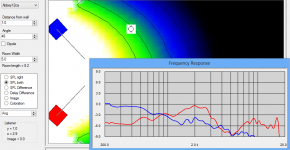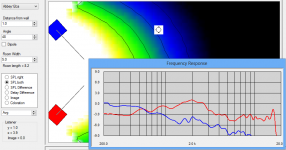Pretty please?
How about a switch for +-9 or +-18?
Those are the errors that I always see and I have no idea what the problem is. It reads like your computer just won't download the files. My guess is that it is the security level of your computer. It is trying to protect you from my bad software!!
Hmmm, just running regular MS Security Essentials and MS Firewall.
I don't know how to read error logs but if you'd like me to try different settings/configurations in order to troubleshoot, I'd be happy to.
Anybody have any idea what I could play with to avoid those errors?
Cheers,
Jeff
Last edited:
Why smaller than 50 degree opening angle? It works for me at anything above about 40 degrees.
Yes, I can change the range, but I have found that the "dipole" button, which normalizes the curves at a different frequency, usually works.
"Above" 40° degree? You mean "below"? Here's 60° opening angle:
This is 45° opening angle (typical home theater):
Only the latter gives a broadband level difference of about 3-6dB. I think that's not enough for proper trading. This suggests that speaker directivity should be higher.
Additional remarks:
- The Dipole button moves the curves even further out of the FR window.
- Wall distance jumps back to 0 when new speaker data is chosen. Value should be retained.
- Hard to set listening position. Either the position should be draggable with live update of x/y value or x/y values should be an editable text field.
- Where's the acoustic center? 30cm from the front wall?
Attachments
Last edited:
I don't understand what you mean by "opening angle". The pointing angle is the same in those two plots - 48 degrees.
The listening grid is rather course which is why the listener is hard to place precisely it jumps to the nearest calculated location. Since the entire field must be recalculated for any change a finer grid slows things down very fast.
There is no "front wall", in this app there basically are no walls at all. The speakers are at x = 0.
You observations may be correct - you are at extreme off axis seating locations. The point is that no speaker does what you are looking for. Trading does occur for even small dB differences, just look at the Blauert data. But nothing is going to correct the seating locations that you are at in the above examples. And once again you are implying that what so many have noted does work for them will not work. The "image" plot corresponds well with my experience.
You will miss the entire point if you continue to look for the "ideal". There is no "ideal" only real speakers and all their flaws.
The listening grid is rather course which is why the listener is hard to place precisely it jumps to the nearest calculated location. Since the entire field must be recalculated for any change a finer grid slows things down very fast.
There is no "front wall", in this app there basically are no walls at all. The speakers are at x = 0.
You observations may be correct - you are at extreme off axis seating locations. The point is that no speaker does what you are looking for. Trading does occur for even small dB differences, just look at the Blauert data. But nothing is going to correct the seating locations that you are at in the above examples. And once again you are implying that what so many have noted does work for them will not work. The "image" plot corresponds well with my experience.
You will miss the entire point if you continue to look for the "ideal". There is no "ideal" only real speakers and all their flaws.
I don't understand what you mean by "opening angle".
Angle between the left and right speaker viewed from the listening position.
There is no "front wall", in this app there basically are no walls at all. The speakers are at x = 0.
Good to know. I had assumed they are at x=30.
The point is that no speaker does what you are looking for.
Exactly why I'm saying "it doesn't work" because there's never enough level difference.
You will miss the entire point if you continue to look for the "ideal". There is no "ideal" only real speakers and all their flaws.
A matrix decoded center works better.
Why do you ignore what I say? It does work. Your example is at an extreme location and completely misses the fact that there is enough level difference when the delay differences are not extreme. But once the delay difference becomes extreme then only extreme level differences work. You just keep ignoring the Blauert data on which all of this is based. If you don't think that Blauert is right then say that - basically that is what you have been saying.Exactly why I'm saying "it doesn't work" because there's never enough level difference.
A matrix decoded center works better.
Also completely beside the point. There is no center channel is this study.
Why is your goal to negate everything that is being discussed by going to the extreme position? That is all too common of the "esoteric audiophiles" around here, but not what I would expect from you. Sound reproduction is a series of tradeoffs - nothing is ever ideal. The goal is to find the best tradeoffs, not to be shackled by seeking a perfection that can never happen.
Last edited:
Why do you ignore what I say?
I don't ignore what you say. Your definition of "it works" is "there is some effect". My definition of "it works" is "there is 1:1 trading".
There is no "front wall", in this app there basically are no walls at all.
Markus,I'd think that now the contralateral reflection becomes pretty significant.
You don't read that from the app, don't you?
Rudolf
Markus,
You don't read that from the app, don't you?
Rudolf
Yes, Markus reads into all he sees that reflections are more important than coherence of the source responsible for them.
Yes, Markus reads into all he sees that reflections are more important than coherence of the source responsible for them.
Not true. I equalize my speakers. But what's left after doing that?
Last edited:
Measuring the coherence of the speaker in the listening plane to see how timing cues from speaker change through small angle differences in the polar response:
From perspective of speaker at 2 meters from listener, ears subtend angle of about 3 degrees.
From ears perspective, speaker response is superposition sum of all radiating points. Driver beaming, breakup, diffraction/reflection from cabinet/baffle change IR response traveling to each ear. Changes in relative zero crossing times of the two slightly differing impulse responses are convolved with speaker signal, resulting in changes of spacial cues heard by each ear. This is independent of HRTF related changes of signals.
These are timing changes much less than 0.1ms. The differences allow localization of the speaker with small changes in head position naturally occurring while listening.
These effects become much worse when IMD is present.
When two such speakers are used for phantom image formation the impact is loss of spatial detail, and unmaking of speaker locations.
Markus, you go on and on with your purported understanding of sound based on reading, yet don't appear to have an audio editor that allows you to conduct real measurement and analysis. This situation is not unique to you, and is reason why most threads in forum are clogged up with virtually no beneficial content. Blind leading blind with defensive language in guise of polite, socially acceptable banter.
The 'Texas' headphone approach with isolation barrier demonstrating improved image detail is simple proof that wall reflections are not important in phantom image formation, leaving speaker as culprit.
The crappier the speakers, the more amazing the barrier effect is. From standpoint of coherent speakers that disappear and take walls with them, the effect is mediocre at best.
From perspective of speaker at 2 meters from listener, ears subtend angle of about 3 degrees.
From ears perspective, speaker response is superposition sum of all radiating points. Driver beaming, breakup, diffraction/reflection from cabinet/baffle change IR response traveling to each ear. Changes in relative zero crossing times of the two slightly differing impulse responses are convolved with speaker signal, resulting in changes of spacial cues heard by each ear. This is independent of HRTF related changes of signals.
These are timing changes much less than 0.1ms. The differences allow localization of the speaker with small changes in head position naturally occurring while listening.
These effects become much worse when IMD is present.
When two such speakers are used for phantom image formation the impact is loss of spatial detail, and unmaking of speaker locations.
Markus, you go on and on with your purported understanding of sound based on reading, yet don't appear to have an audio editor that allows you to conduct real measurement and analysis. This situation is not unique to you, and is reason why most threads in forum are clogged up with virtually no beneficial content. Blind leading blind with defensive language in guise of polite, socially acceptable banter.
The 'Texas' headphone approach with isolation barrier demonstrating improved image detail is simple proof that wall reflections are not important in phantom image formation, leaving speaker as culprit.
The crappier the speakers, the more amazing the barrier effect is. From standpoint of coherent speakers that disappear and take walls with them, the effect is mediocre at best.
Markus, you go on and on with your purported understanding of sound based on reading, yet don't appear to have an audio editor that allows you to conduct real measurement and analysis.
*sigh* Wrong again.
The 'Texas' headphone approach with isolation barrier demonstrating improved image detail is simple proof that wall reflections are not important in phantom image formation, leaving speaker as culprit.
What proof do you have that crosstalk is no factor?
Thanks
Played around some more and found for all your speakers and the 2-way horn that a toe-in of 50° and higher gives the broadest level difference. I'd think that now the contralateral reflection becomes pretty significant.
Yes, I saw that too.
Adding reflections to the calcs is easy, but displaying the results is not so easy. You can't just add the data from the direct and reflection together - what would that show? I haven't added boundaries because I don't know how to display the results.
I know you would have suggestions, but in all likelihood they would not be doable in a simple app like this. There is no head model, that's a major complication since I know of no actual 3D HRTF algorithms. At least none that are simple. I wrote some code years ago that would do this, but it was a complex calculation for each and every axis. Way to complex to do in real time.
- Status
- This old topic is closed. If you want to reopen this topic, contact a moderator using the "Report Post" button.
- Home
- Loudspeakers
- Multi-Way
- New study on loudspeaker placement

